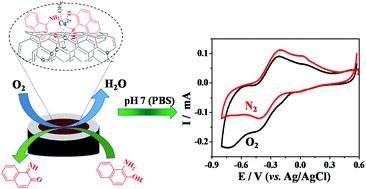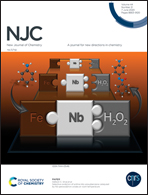Oxygen sensitive 1-amino-2-naphthol immobilized functionalized-carbon nanotube electrode
Abstract
Herein, we account for a modified glassy carbon electrode with a copper-1-amino-2-naphthol (AN–Cu2+) complex immobilized on a carboxyl-functionalized multiwalled carbon nanotube (f-MWCNT) (GCE/f-MWCNT@AN–Cu2+). It is employed for the electrochemical detection of dissolved oxygen (DO) in 0.1 mol L−1 phosphate buffer solution (PBS). The oxygen reduction reaction was exclusively catalyzed by the AN coated f-MWCNT. Cu2+ was merely used to immobilize AN on the f-MWCNT to enhance the stability of the electrode. To prove the interaction between O2 and AN, a dilute solution of AN in pH 7 PBS was monitored by purging N2 and O2, and an intense turbidity was observed, with O2 indicating the adduct formation between AN and O2. The prepared sensor exhibits an excellent tolerance to interferents which are found in water samples along with oxygen. The Koutecky-Lévich analysis confirms the four-electron reduction of O2. Moreover, reproducibility, stability, the limit of detection (LOD), and sensitivity of the modified electrode were found to show the capability of the proposed sensor for monitoring the DO content.



 Please wait while we load your content...
Please wait while we load your content...